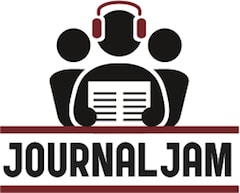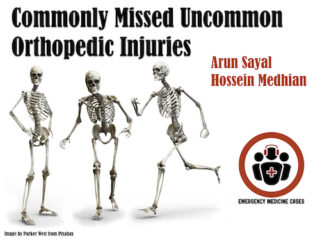Most Recent
Episode 55: Fluids in Sepsis, Post-intubation Analgesia and Sedation
In this second part of the Weingart-Himmel Sessions on critical care pearls for the community ED on the EM Cases podcast, we discuss the many controversies and recent changes in fluid management in severe sepsis and septic shock. With the recently published ARISE trial, and some deviations from Early Goal Directed Therapy, we are changing the way we think about fluids in sepsis: the type of fluid, the volume of fluid, the rate of fluid administration, the timing of introducing vasopressors and the goals of fluid resuscitation. In the next section of the podcast we discuss the PAD mnemonic for post-intubation analgesia and sedation, the prevention of delirium, and medication choices to minimize time on the ventilator, and improve prognosis.
Journal Jam 2: Small Bore Chest Tube and Outpatient Management of Pneumothorax
It makes sense that the treatment of primary spnontaneous pneumothorax would lend itself well to outpatient management, since patients are usually young and otherwise healthy, and the mortality and morbidity from these air leaks are really very low. Most patients would rather be managed as an outpatient rather than admitted to hospital and sending these patients home would probably end up saving the system resources and money. In this month's Journal Jam Podcast on small bore chest tube and outpatient management of pneumothorax, the highlighted article that Anton Helman and Teresa Chan discuss is Voison et al. on the “Ambulatory Management of Large Spontaneous Pneumothorax With Pigtail Catheters.” We hear from Michelle Lin, Seth Trueger, Heather Murray and the lead author himself, Stephan Jouneau. Questions posed include: In what ways is the use of small bore catheters with Heimlich valves for spontaneous pneumothorax better than needle aspiration? Is it necessary to repeat a CXR after placement of the catheter? Who should follow up these patients after they are discharged from the hospital? How can we minimize kinking and dislodgement of the catheter? and many more..... [wpfilebase tag=file id=523 tpl=emc-play /] [wpfilebase tag=file id=524 tpl=emc-mp3 /]
Episode 54: Preoxygenation and Delayed Sequence Intubation
Hot on the heels of Dr. Weingart's latest publication in the Annal of EM on Preoxygenation & Delayed Sequence Intubation, we have Dr. Weingart, perhaps the world's most influential critical care educator, and Dr. Walter Himmel, 'The Walking Encyclopedia of EM' discussing how the community ED doc can use preoxygenation, apneic oxygenation and delayed sequence intubation to help improve airway management knowledge and skills. Whether you work in a rural setting or a big urban community hospital, Dr. Himmel and Dr. Weingart explain how these concepts and skills are easily adaptable to your work environment. We introduce the Triple 15 Rule for preoxygenation as a memory aid that will help you the next time you're faced with a critically ill patient who's oxygen saturation isn't good enough on a non-rebreather.
Episode 53 Pediatric POCUS
In this Episode, a follow up to Episode 18 Point of Care Ultrasound Pearls and Pitfalls, which covered pericardial effusion, pneumothorax, undifferentiated shock, cardiac arrest & DVT, we bring you 4 of North America’s Pediatric Point of Care Ultrasound gurus recorded live from Toronto during the first ever P2 Conference (PEM POCUS) - Pediatric Emergency Medicine Point of Care Ultrasound. The format will be a bit different for this episode. I’ve asked each our P2 gurus to describe a case that illustrates their favorite point of care ultrasound application, why they think it is useful, how it improves patient care, a step by step description of how to perform the application, the pearls and pitfalls of the application, and bit about what the literature says about the application. Dr. Jason Fischer on ultrasound-guided nerve blocks, Dr. Alyssa Abo on pediatric lung POCUS, Dr. Adam Sivitz on pediatric appendicitis POCUS and Dr. Alex Arroyo on intussesception.
A Rational Approach to Emergency Ebola Preparedness
In this special 15 minute EM Cases podcast on Ebola preparedness we bring you an interview with Professor Howard Ovens, the director of emergency medicine at Mount Sinai Hospital in Toronto. As an EM physician who took care of many SARS patients and the chief of the ED during the SARS outbreak, Dr. Ovens has a very rational approach to how to prepare our emergency departments for patients who present with fever who have been traveling in an Ebola outbreak region, including triaging and personal protective equipment (PPE).
Episode 52: Commonly Missed Uncommon Orthopedic Injuries
We rarely discuss medico-legal issues on EM Cases because it misguides us a bit from good patient centered care – which is what emergency medicine is really all about. Nonetheless, missed orthopedic injuries are the most common reason for an emergency doc to be sued in Canada. This is partly because missed orthopedic injuries are far more common than missed MIs for example, but it’s also because it’s easy to miss certain orthopedic injuries – especially the ones that aren’t super common. And orthopedics is difficult to learn and remember for the EM practitioner as there are so many injuries to remember. And so, you guessed it – on this episode we’re going to run through some key not-so-common, easy to miss orthopedic injuries, some of which I, personally had to learn about the hard way, if you know what I mean. After listening to this episode, try some cognitive forcing strategies – for every patient with a FOOSH that you see, look for and document a DRUJ injury. Wait, hold on….I don’t wanna give it all away at the top of the post. Let’s hear what EM doc and sports medicine guru Ivy Cheng, and the orthopedic surgeon who everyone at North York General turns to when they need help with a difficult ortho case, Hossein Medhian, have to say about Commonly Missed Uncommon Orthopedic Injuries.







